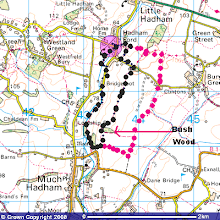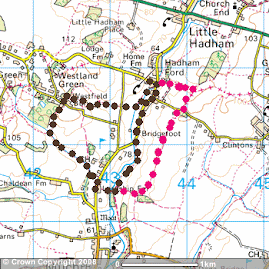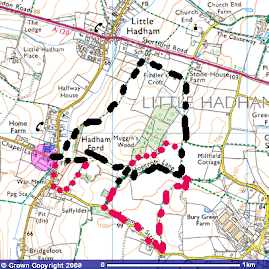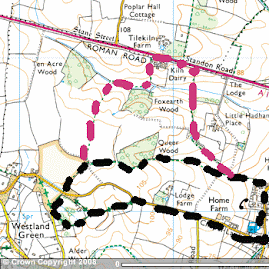With a new national lockdown commencing on Thursday for at least 4 weeks, I suspect there will be many who will be making the most of this time to get out for walks in the countryside.
Last lockdown I put up a series of walks that are all around Bishop's Stortford and I shall paste links to these at the end of this blog entry.
Whilst there are considerably fewer insects about now there are plenty of other wildlife species that, with a little searching in the correct habitat will be relatively easy to find.
Birds:
Probably the easiest to find will be the larger birds such as crows, rook, jackdaws and gulls. These can be seen, often in large numbers on playing fields and ploughed fields. A check on the football fields at Grange Paddocks would be a good start for these and with a pair of binoculars it is not too tricky to pick out different birds. Black headed gulls (red beak, spot behind the eye) Lesser black backed gull (dark grey, yellow legs) Herring gull (pink legs, lighter grey with brown speckling on head and neck and Common gull (smaller, light grey, yellow bill with black stripe and greeny/yellow legs) may all be present.
 |
| In here: 7 Black headed gulls, 4 Common gulls, 3 Lesser black backed gull, 1 Herring gull and a random Lapwing. Can you spot them? |
Carrion crows (black bill) Rook (silver grey pointed bill and showing shaggy feathers on legs) and Jackdaws (smaller with a grey nape and sparkling blue/grey eye) will also be present in numbers.
Large flocks of starlings will also be feeding on the ground. At first sight a black bird but upon closer inspection, often covered with white spots and in sunlight, showing purples, greens and blues.
Also thrushes and blackbirds. Fieldfares (large birds, speckled breast shaded golden and very noisy. their chack chack call gives away their presence can be found both feeding on the ground and in berry trees as can the smaller Redwing with its very distinctive white eyebrow and red "armpits" when in flight. Usually silent but can give a thin, wispy call when in flight parties. The large mistle thrush with speckled breast and overall grey appearance and smaller Song thrush with its arrow head spots on the breast can also be found in good numbers.
 |
| Meadow pipit |
In seed bearing trees, particularly alders there will be a good chance of seeing both Lesser redpoll and Siskin. Latter a greeny/yellow finch in female and first year birds with the male being a striking yellow and black bird. Often in parties of up to 70 at a time. The Lesser redpoll is a light grey bird that can feed, like the siskin, hanging upside down from the alder cones. It shows a small red patch on the forehead, the rest of the plumage a grey/white streaking.
Residents such as Chaffinches, Goldfinches and Greenfinches will be seen in good numbers wherever there is food, both seeds and berries. Bullfinches become more obvious at this time of the year as the leaves drop and they often gather together in parties so if you see one flying, showing a very obvious white rump, hang around a while as there is every possibility there will be more following. Their call is like a squeaking iron gate. Fairly quiet but distinguishable.
 |
| Chaffinch |
Jay numbers increase in winter with many migrating over the North Sea from Scandinavia. These are colourful birds that associate with oak woods. Magpies, of course will be everywhere.
 |
| Little grebe |
On ponds and rivers there may well be an increase in wildfowl, with the ever present mallards making up most of the numbers but always worth checking for other species such as Gadwall, Shoveler, pochard and teal. Coots and Moorhens will also be present and on larger stretches of water, Little grebe will be found, such as along the Stort both north and south of Spellbrook locks.
 |
| drake Teal |
 |
| drake shoveler |
 |
| Gadwall pair |
Birds of prey can be seen more frequently in winter as the short hours of daylight force them to maximise their hunting times, so Kestrels (the only bird of prey that hovers) found along hedgerows whilst Sparrowhawks will visit gardens, especially if you have bird feeders about whilst Red kites and Common buzzards will almost certainly be a daily sight.
Great spotted woodpeckers can be seen more frequently as the leaves drop from deciduous trees but always check for the smaller (sparrow sized) Lesser spotted woodpecker. By the end of December it will be likely that the GSW will already be drumming its territorial call. This lasts for a few seconds and is regularly repeated.
 |
| Great spotted woodpecker (female as no red on neck) |
Tawny owls and Little owls will be calling at night. Twitt twoo call of the tawny is well known. I liken the call of the little owl to the soundtrack to the shower scene in the film Psycho. You'll recognise it when you hear it.
 |
| Tawny owl found on the side of the road. Made full recovery at a vets who named it Deidre. I put the gardening gloves on as the talons are razor sharp. |
Along rural hedgerows the yellowhammer will be overwintering in good numbers. Also here, as just about everywhere, Great, Blue and Long tailed tits and, if near conifers, a chance of a Coal tit, showing a white oblong on the back of the head. Also, in trees growing in hedgerows both nuthatch and tree creeper are possible.
 |
| Tree creeper |
Plenty of other birds will be encountered, this just to give a flavour of what may be found on any wander along the footpaths surrounding Stortford.
Insects:
The butterflies and dragon/damselflies have just about finished now. On a sunny day before the first frost it may be possible to come across one or two. There will be some wasps still about, craneflies, and several fly species. All these can be found by checking any flowerheads on footpaths as well as in the garden. Here are a few from my garden today, 01.11.2020
Signs of insects can be found, especially in leaf mines on the brown leaves. Look for marks on the leaves that look like tunnels. These will be made by tiny caterpillars that munch there way around the leaves. This leaves a very distinctive trail that, when the tree species is known and the pattern of the mine is known, can be identified to species. Children love looking for these and they are very easy to find. To get started, check on well known trees like apple, hazel and hawthorn. Hold the leaf up to the light and you may be able to see the caterpillar still inside. Alternatively, there will be a hole where the cat has eaten its way out to pupate.
Garden or Woodland Activity: Stuff an old pair of tights with leaves picked up from the woodland floor or the garden lawn. When full, leave under a hedge all winter and into spring and in about April, bring it in to a warmer place such as a garage or shed. In mid May, tip out the contents whereupon you'll come across loads of tiny moths, a few beetles and several fly species that were all pupating in or on the leaf litter.
Worth also picking up leaf litter in woodland habitats to check for ground beetles. There are a few that can be found throghout the winter.
Spiders:
Most spiders will be finished by now, but a wander around the garden with a torch may turn up several species as well as checking sheds, garages and corners of ceilings. One that is still in the garden is Araneus diadematus, the Garden cross spider. Females make a web each day and usually sit in the middle of it. Look for this near security lights or outside patio lights. This sort of habitat can also attract other spider species, too. Sitting here in my shed/office I can see 3 spiders, two species as I am typing. Here's one of them.
 |
| Zygiella x notata |
Links to walks:
https://littlehadhambirding.blogspot.com/2020/05/local-walk-6-west-from-tescos-to-bury.html
https://littlehadhambirding.blogspot.com/2020/05/local-walk-5-thorley-church-spellbrrok.html
https://littlehadhambirding.blogspot.com/2020/05/local-walk-4-start-and-finish-at.html
https://littlehadhambirding.blogspot.com/2020/05/local-walk-3-little-hadham-area.html
https://littlehadhambirding.blogspot.com/2020/05/local-walk-2-flitch-way-with-extension.html
https://littlehadhambirding.blogspot.com/2020/05/walks-around-stortford-walk-1-from.html
Hope these help and that the walks are not too muddy. Note, they are at present!! I shall add extra details as I think of them in edits here. Plenty to find, just have to look a little closer. Good luck and I look forward to hearing about where you went and what you saw.
















































3 comments:
Redpolls are brown not grey
Agreed but when hanging upside down they appear lighter on the breast in good light and therefore can appear grey. Streaked brown on wings and back with 1st year birds showing a white tramline down the back from the nape.
What a beautiful pictures!
If you want to see more photos of birds, I share you my blog.
https://avesdecordobayargentina.blogspot.com
Post a Comment